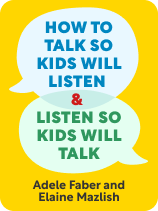

This article is an excerpt from the Shortform book guide to "How to Talk So Kids Will Listen & Listen So Kids Will Talk" by Adele Faber and Elaine Mazlish. Shortform has the world's best summaries and analyses of books you should be reading.
Like this article? Sign up for a free trial here.
Want to know some techniques for promoting autonomy in early childhood? Why is autonomy important for children?
Educators Adele Faber and Elaine Mazlish claim that fostering autonomy in early childhood is important for children to feel empowered and to create a stronger parent-child relationship. In How to Talk So Kids Will Listen & Listen So Kids Will Talk, they offer six techniques to promote early childhood autonomy.
Read on to learn Faber and Mazlish’s six techniques for encouraging autonomy in early childhood.
Promoting Autonomy in Early Childhood
The advice in Adele Faber and Elaine Mazlish’s book How to Talk So Kids Will Listen & Listen So Kids Will Talk teaches parents how to communicate in a way that shows children you hear them and care about how they feel. In the book, Faber and Mazlish claim that giving your child a level of autonomy that’s developmentally appropriate is an important key for improving parent-child communication. This will make them feel empowered in the relationship, create a smoother, give-and-take relationship, and make your child more cooperative. In this article, we’ll explain why it’s important to promote autonomy in early childhood and six techniques for increasing a child’s autonomy, according to the advice in How to Talk So Kids Will Listen & Listen So Kids Will Talk.
The Importance of Autonomy
Showing that you empathize with your children’s feelings sets the stage for cooperation and promotes their sense of autonomy. To build on that, Faber and Mazlish suggest approaches that depersonalize the conflict so it’s no longer a war between you and your child but a cooperative endeavor instead.
Gaining children’s cooperation is key because parents have to stop their children from doing so many things—putting Barbie shoes up their nose, riding the dog—and this can make you seem like an enemy. When you get locked in a power struggle with your child, no one wins.
Faber and Mazlish recommend that you focus not on your authority but on solving the problem that needs solving. When you focus on solutions, your child may be able to suggest some creative approaches you haven’t thought of. In early childhood, allowing kids to come up with ways of addressing the problems they face helps to foster their autonomy.
| Early Childhood Autonomy & Self-Esteem Why is autonomy so critical in early childhood? According to psychologist Eric Erikson’s stages of development, a sense of autonomy develops during the toddler years, from 18 months to three years old—years that are often recognized as difficult or “the terrible twos” because children start insisting on their own wants. This stage is a natural part of child development. If parents don’t sufficiently foster this sense of independence and capability, a child might feel doubtful about their abilities, become dependent and overly cautious, and have low self-esteem. |
To get off on the right foot, here’s what not to do if you’re trying to promote early childhood cooperation and autonomy, according to the authors. Don’t blame or accuse your children of negative traits, like being messy or clumsy or never listening. Don’t threaten them, use sarcasm, issue commands, lecture them at length, or compare them to others.
Now, here’s what Faber and Mazlish say you should do instead.
#1: Neutrally Communicate Facts
Describe the problem: You may feel like telling your child, “You always make a mess! I’m tired of it. Do you live in a barn?” But if you’re angry, your child may automatically get defensive and argumentative in response. This pits you against your child. A better approach is to calmly observe: “I see muddy boots on the living room floor.” When you point out an issue, your child has a chance to suggest a solution, which is an excellent skill to learn, and your conversation remains focused on the problem and how to address it.
#2: Give Information
Equip your child with the knowledge they need to make the right decision. For example, if they’re trying to give the dog their snack, tell them, “If you feed a dog chocolate, they might get sick.” Then they can draw their own conclusion: “I’d better not feed the dog chocolate.” If they realize themselves what the right thing is to do, they’re more likely to do it.
#3: Offer Options
Offer two options that you find acceptable—for instance, suggest your child wear either the red or blue pajamas, and let them choose. This can feel empowering to them because they enjoy selecting an option, and they feel that you value their input.
#4: Be Concise
Don’t pepper your child with questions; the more you speak, the less room they have to think or respond. Instead of a lecture, call attention to a task with one word. “Teeth!” “Groceries!” Let children figure out what the problem is and how they can solve it.
| Use Scaffolding to Encourage Autonomy Hand-in-hand with giving information and options, parents can use scaffolding in early childhood to encourage their child’s autonomy. Just as scaffolding is a temporary structure that provides support for a building that’s under construction, educational scaffolding provides support for a child while they’re learning to do things themselves. With this support, a child can feel more comfortable taking the next step, and the adult gradually takes down the scaffolding, meaning they do less and less for the child as the child learns how to master the skills they need. Another approach that can help foster a child’s independence is by letting them fail and try again. If parents swoop in too soon to help a child, that child isn’t able to develop healthy coping strategies around failure, and that can make the child afraid to try because they might be afraid of making a mistake. It’s only when children are given the space to try things, make mistakes, and try again that they develop the resilience they will need in their later lives. |
#5: Write It Down
Instead of nagging your children, the authors suggest writing a note reminding them to hang up their wet jacket or put the toilet seat down. Notes on paper can seem more authoritative to children than spoken reminders. If your kids are always raiding the kitchen, you could put up a sign saying “Pantry Closed” after their snack. The authors encourage whimsical approaches, like notes written from the point of view of a towel that say, “Don’t leave me on the floor! Hang me up on the hook on the door!”
(Shortform note: Writing notes to your children fits Faber and Mazlish’s general strategy of depersonalizing rules and making daily life less of a power struggle between parents and children. It makes clear that these tasks are not just arbitrary things you want them to do because you’re annoying, but things that need to be done for the house to run smoothly.)
#6: Share Your Feelings
Let your children know how their actions affect you. You can tell them, “I don’t like being poked when you’re trying to get my attention. Please use words.” If you’re feeling tired or frustrated, you can share these feelings with them in a memorable way—for instance say something like, “My patience is the size of a tiny mouse.” In better times, you can tell them, “My patience is as big as an elephant.”
The more authentic you are with your children, Faber and Mazlish say, the more honest they will be with you. The authors also claim that another way to promote early childhood autonomy is jettisoning any fixed ideas you might have formed about them.
(Shortform note: Along with sharing your own feelings, Dr. Laura Markham advises parents to practice self-care and treat their feelings as valid and worthy of attention. If you feel overwhelmed, give yourself what you need in the moment, if you can–for example, a five-minute break or a cup of coffee. Schedule it for later if now is impossible.)

———End of Preview———
Like what you just read? Read the rest of the world's best book summary and analysis of Adele Faber and Elaine Mazlish's "How to Talk So Kids Will Listen & Listen So Kids Will Talk" at Shortform.
Here's what you'll find in our full How to Talk So Kids Will Listen & Listen So Kids Will Talk summary:
- How to build mutually respectful relationships with your children
- How to make your children feel heard and understood
- Methods for effectively praising and scolding your children






